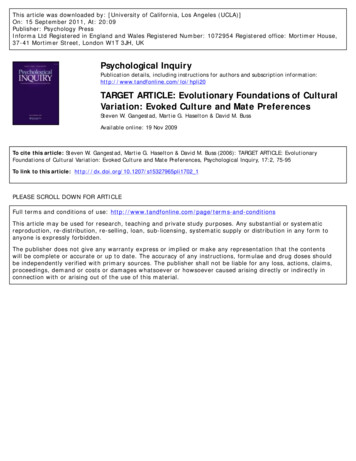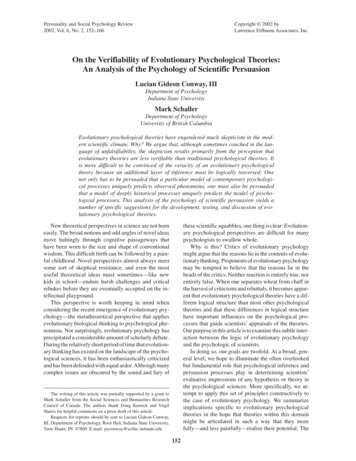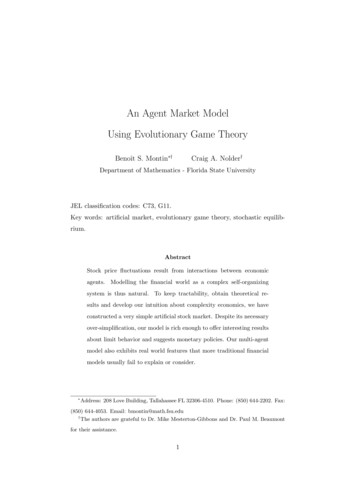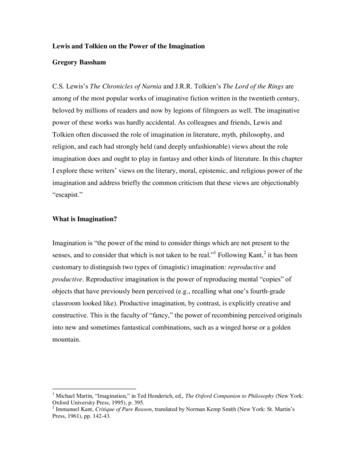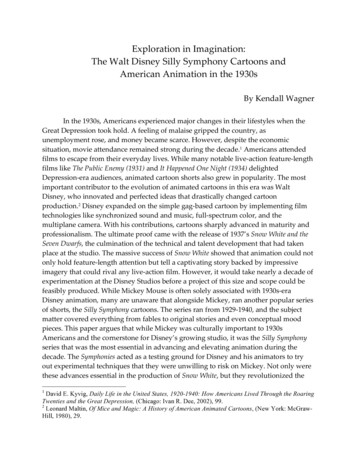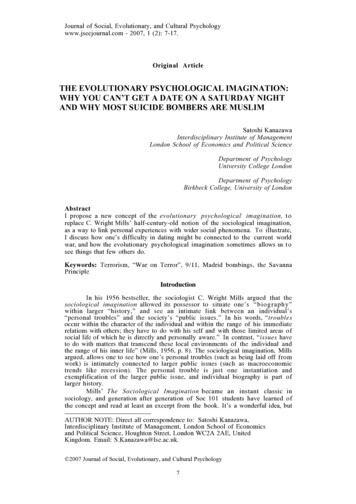
Transcription
Journal of Social, Evolutionary, and Cultural Psychologywww.jsecjournal.com - 2007, 1 (2): 7-17.Original ArticleTHE EVOLUTIONARY PSYCHOLOGICAL IMAGINATION:WHY YOU CAN’T GET A DATE ON A SATURDAY NIGHTAND WHY MOST SUICIDE BOMBERS ARE MUSLIMSatoshi KanazawaInterdisciplinary Institute of ManagementLondon School of Economics and Political ScienceDepartment of PsychologyUniversity College LondonDepartment of PsychologyBirkbeck College, University of London.AbstractI propose a new concept of the evolutionary psychological imagination, t oreplace C. Wright Mills’ half-century-old notion of the sociological imagination,as a way to link personal experiences with wider social phenomena. To illustrate,I discuss how one’s difficulty in dating might be connected to the current worldwar, and how the evolutionary psychological imagination sometimes allows us t osee things that few others do.Keywords: Terrorism, “War on Terror”, 9/11, Madrid bombings, the SavannaPrincipleIntroductionIn his 1956 bestseller, the sociologist C. Wright Mills argued that thesociological imagination allowed its possessor to situate one’s “biography”within larger “history,” and see an intimate link between an individual’s“personal troubles” and the society’s “public issues.” In his words, “troublesoccur within the character of the individual and within the range of his immediaterelations with others; they have to do with his self and with those limited areas ofsocial life of which he is directly and personally aware.” In contrast, “issues haveto do with matters that transcend these local environments of the individual andthe range of his inner life” (Mills, 1956, p. 8). The sociological imagination, Millsargued, allows one to see how one’s personal troubles (such as being laid off fromwork) is intimately connected to larger public issues (such as macroeconomictrends like recession). The personal trouble is just one instantiation andexemplification of the larger public issue, and individual biography is part oflarger history.Mills’ The Sociological Imagination became an instant classic insociology, and generation after generation of Soc 101 students have learned ofthe concept and read at least an excerpt from the book. It’s a wonderful idea, butAUTHOR NOTE: Direct all correspondence to: Satoshi Kanazawa,Interdisciplinary Institute of Management, London School of Economicsand Political Science, Houghton Street, London WC2A 2AE, UnitedKingdom. Email: S.Kanazawa@lse.ac.uk. 2007 Journal of Social, Evolutionary, and Cultural Psychology7
Evolutionary Psychological ImaginationI think we need to update it a bit. It’s been more than half a century since Millsproposed the idea, and our understanding of human behavior -- our ability t oexplain “personal troubles” -- has advanced significantly since then. In 1956, wedidn’t have evolutionary psychology; in 1956, we didn’t even have inclusivefitness and kin selection (Hamilton, 1964), let alone parental investment(Trivers, 1972), the cheater detection module (Cosmides, 1989) (or any otherevolved psychological mechanism), or The Mating Mind (Miller, 2000). RobertTrivers was in junior high school; neither Leda Cosmides nor Simon Baron-Cohenhad even been born yet. Really, what could we possibly know about humanbehavior without evolutionary psychology?I concur with Mills that our ability to situate our “biography” withinlarger “history,” by linking our “personal troubles” to the society’s “publicissues,” is very important. Since all good science is reductionist (Coleman, 1990;Weinberg, 1992), we should be able to explain “public issues” at the macro levelin terms of “personal troubles” at the micro level, and vice versa. Societal,macroeconomic, and political phenomena should be explainable in terms ofindividual behavior. It is my belief, however, that, because evolutionarypsychology is a far better perspective for understanding human behavior thansociology ever was or will be, the evolutionary psychological imagination willallow us to see even more intimate links between our personal troubles and publicissues. Now that we have evolutionary psychology, it’s time that we replaced thesociological imagination with the evolutionary psychological imagination.1The evolutionary psychological imagination first allows you to see theuniversality of human nature and realize that, to a large extent, people are thesame everywhere. It diverts your attention from the particular, the exceptional,the individual, and the local, and focuses your attention to the universal and thecommon in human experiences. Just like the sociological imagination, theevolutionary psychological imagination then allows you to connect “biography”and “history,” and link “personal troubles” with “public issues.” Unlike thesociological imagination, however, the evolutionary psychological imaginationdoes so by emphasizing the biological and evolutionary foundations of humanbehavior and social phenomena, and the interaction of social and cultural factorswith such biological and evolutionary foundations. Social and cultural factorsimpact human behavior only through the evolved human nature. Theevolutionary psychological imagination reminds us that, in the words ofinimitable Laura Betzig, “people are animals” (Betzig, 1997).Personal Troubles: Why You Are Spending Every Saturday Night AloneIf you are chronically spending every Saturday night alone, despite valiantand persistent effort to find a date, then chances are there’s something wrongwith you, at least in this area of life. You probably don’t possess the qualities thatmembers of the opposite sex seek in potential mates. Evolutionary psychologicalresearch has not only discovered what these traits are that men and women seekin each other, but also that the traits sought after by men and women areculturally universal; men everywhere in the world seek the same traits in women(such as youth and physical attractiveness) and women everywhere in the world1In 1991, Mary Maxwell published an edited book called The Sociobiological Imagination.Albeit an excellent book in its own right, it was not an attempt to update the sociologicalimagination, as Maxwell herself admits on the first page of the book. It is a collection of essays,written by early pioneers of sociobiology in various fields, and demonstrating how the knowledgeof sociobiology can illuminate traditional social sciences and humanities.Journal of Social, Evolutionary, and Cultural Psychology – ISSN 1933-5377 – Volume 1(2).2007.8
Evolutionary Psychological Imaginationseek the same traits in men (such as wealth and status) (Buss, 1989). In fact, oneof the themes of evolutionary psychology is that human nature is universal (or“species-typical”) and people are the same everywhere (or their culturaldifferences can be explained by the interaction of universal human nature and thelocal conditions) (Cosmides & Tooby, 1992; Kanazawa, 2006). You may becomforted to know that you are not alone in your plight; there are losers like youeverywhere in the world, and for the same reasons.The evolutionary psychological imagination, however, also tells you thatyour personal troubles are not entirely your own doing; there are larger forces atwork to keep you alone on a Saturday night. For example, if you consistentlyfind yourself dateless, chances are you are a young man, not a young woman. Onany given Saturday night, more young men than young women find themselvesdateless, even though the sex ratio in society is always roughly 50-50 and thereare about the same number of young men as young women. This is becausehumans are naturally polygynous (Alexander et al, 1979; Kanazawa & Still,1999), and throughout evolutionary history some men have always had multiplemates. The mathematical consequence of polygyny is most obvious in societiesthat sanction and practice (simultaneous) polygynous marriage, such as manyAfrican tribes and Muslim societies in the Middle East. If every married man hasfour wives, for example, it means that, given a 50-50 sex ratio, three-quarters ofmen are left mateless. A large majority of men in such societies are in the samesituation as you are; they find themselves alone on a Saturday (and every other)night.However, as Daly and Wilson (1988, pp. 140-142) point out, “polygynyis a matter of degree” in human mating systems; every human society is more orless polygynous, even in an officially monogamous society like the United States.This is both because some married (or otherwise already-mated) men acquire andkeep additional mates (in the form of mistresses and girlfriends)2 and because menin such nominally monogamous societies practice serial polygyny, where divorcedmen go on to marry younger women in their second and subsequent marriages.One of the strongest predictors of remarriage after divorce is sex; men oftenremarry, women often don’t.Now if men only practice serial polygyny and do not acquire multiplemates simultaneously, then it means that there are an equal number of availablewomen as available men. However, given men’s preference for younger womenand women’s preference for older men (Buss, 1989; Kenrick & Keefe, 1992),most of the now available women are older women who have been married anddivorced and have had some children, while most of the available men are youngmen yet to have their reproductive opportunities (if they are lucky). They donot make good matches for each other. In polygynous societies (eithersimultaneous or serial), most women get their reproductive opportunities andhave children (if followed by a divorce in the case of serial polygyny), while manymen are left out of their reproductive opportunities altogether for life and spendtheir entire life mateless. The more polygynous the society, the more young menface the distinct possibility of ending their lives as complete reproductive losers.Such is the mathematics of polygyny.2Although more married men than married women have extramarital affairs (24.5% of married menversus 15.0% of married women, according to the National Health and Social Life Survey (Laumannet al., 1994, p. 216, Table 5.15)), some married women do have extramarital affairs and thus acquireadditional mates in the form of lovers and boyfriends. I thank Rosemarie I. Sokol (and CarrieBradshaw) for uncovering my blind spot.Journal of Social, Evolutionary, and Cultural Psychology – ISSN 1933-5377 – Volume 1(2).2007.9
Evolutionary Psychological ImaginationThis bleak prospect, created by polygyny, makes men very competitiveand aggressive, because they must compete fiercely with each other not to be leftout of the reproductive game altogether and to win mates. This is why men inevery human society are more violent and aggressive than women (just as malesof most other species are more violent and aggressive than females) (Trivers,1972). Further, the more polygynous the society, the more aggressive andviolent the men become (Daly & Wilson, 1988; Kanazawa & Still, 2000). This iswhy, among other things, your boyfriend is often insufferably rude to the waiterwhen you go out to dinner. He is trying to impress you in his misguided attemptto put down potential competitors and claim higher status than the waiter. If youare a woman, your “personal troubles” include having to put up with suchimmature behavior of your boyfriends and husbands.Yes, as Mills pointed out, your “personal troubles” are largely the resultsof who you are and how you relate to those in your immediate surroundings. Butit does not mean that they are entirely your fault; there are some forces beyondyour control that contribute to your personal troubles, and the evolutionarypsychological imagination can suggest what these forces might be.Public Issues: World War IIIIn his 1999 book The Lexus and the Olive Tree, the New York Timescolumnist Thomas L. Friedman predicted that the first major war in the 21stcentury, after the end of the Cold War which characterized the latter half of the20th, would not be fought between nations. It would instead be declared by whatFriedman called “super-empowered angry men,” such as, among others, (the thenlittle-known) Osama bin Laden. Such super-empowered angry men would use thepower of modern technology, like the internet, email, and cell phones, to mounta successful war against modern states, possibly even a superpower like the UnitedStates. Two years later, his ominous prediction came true. In his September 13,2001, NYT column, filed from Jerusalem, Friedman once again predicted that theevents in New York and Washington two days earlier signified the start of WorldWar III. Nearly six years later, we are still in the middle of World War III.While World War III is commonly called “the War on Terror,” and ourenemies are collectively known as “the terrorists,” they are very different fromtraditional terrorist groups, such as the Irish Republican Army, ETA (BasqueFatherland and Liberty), the Japan Red Army, and other Marxist revolutionariesthroughout history. Terrorists, traditionally, are those who have clear politicalgoals and are willing to resort to violence and destruction in order to achievethem. For traditional terrorists, what is most important is the political goals, andviolence and destruction are means to their goals; they are not goals themselves.If they could achieve the goals without violence and destruction, they’d prefer t odo so.For example, while the IRA has assassinated many targeted individuals(mostly politicians and British soldiers), they do not aim to kill random civilians.That’s why, when the IRA sets and explodes bombs on commercial targets inBritain, it usually gives a 45-minute advance warning, enough time for theoccupants of the buildings to evacuate them safely, but not enough time to call inthe bomb squad to locate and defuse the bombs (Coogan, 1995, pp. 513-521).While the members of Greenpeace and other eco-terrorist groups often endangertheir own lives, they are not known intentionally to endanger the lives of others.Traditional terrorist groups let the whole world know that they are responsible fortheir acts of violence and destruction, and often court media attention, becausesuch publicity helps spotlight their political goals.Journal of Social, Evolutionary, and Cultural Psychology – ISSN 1933-5377 – Volume 1(2).2007.10
Evolutionary Psychological ImaginationOur enemies in the current “War on Terror” are very different. Theyaim to endanger as many lives as possible, including their own, and they do notseem to have clearly stated political goals (Atran, 2003, p. 1538; Friedman,2002, pp. 144-145). They do not give advance warnings of their attacks, andthey do not even publicly claim responsibility for the violence after the fact(Krueger & Maleckova, 2003, p. 129). (Many of the claims of responsibility onvarious web sites are usually false.) As a result, it appears that, for our currentenemies, the murder and destruction is the goal, rather than means to politicalgoals. That is why, for example, the Palestinians did not stop their suicidebombings even after Israeli government, under Ehud Barak, conceded virtuallyeverything the Palestinians demanded. Yasir Arafat did not call off his suicidebombers even when he achieved his stated political goals, which were the totalwithdrawal of Israelis from the West Bank and the control of Jerusalem(Friedman, 2002, pp. 13-14, 19-20).Why? Why are our current enemies in World War III so different fromtraditional terrorists?Despite varied geography, cultures, languages, and ethnicities, one factorwhich unites all of our otherwise diverse current enemies, from al Qaeda in theMiddle East, to Jemaah Islamiyah in the South East Asia, to the Chechen rebels inRussia, to the Palestinian suicide bombers in Israel, to the Sunni insurgents in Iraq,is Islam. According to the Oxford University sociologist Diego Gambetta, editorof Making Sense of Suicide Missions, a comprehensive history of this topical yetpuzzling phenomenon, while suicide missions are not always religiously motivated,when religion is involved, it is always Islam (Gambetta, 2005, pp. 259-263).Why is this? Why is Islam the only religion that motivates its followersto commit suicide missions? Why is this religion a common factor in ourotherwise diverse enemies in World War III? What (if anything) does it have t odo with your spending Saturday night alone? The evolutionary psychologicalimagination may shed some light on these puzzles.What distinguishes Islam from other major world religions (Christianityand Judaism) is that it sanctions polygyny, and, as we saw earlier, polygynyincreases competitive pressure on men, especially young men of low status, whoare most likely to be left without reproductive opportunities when older men ofhigher status marry polygynously. Polygyny therefore increases the likelihoodthat young men resort to violent means to gain access to mates because they havelittle to lose and much to gain by doing so, compared to men who already havewives. This is why, across all societies, polygyny increases violent crimes, such asmurder and rape, even after controlling for such obvious factors like economicdevelopment, economic inequality, population density, the level of democracyand world regions (Kanazawa & Still, 2000). So the first unique feature of Islam,which partially contributes to the prevalence of suicide bombings among itsfollowers, is polygyny, which makes young men violent everywhere.However, polygyny by itself, while it increases violence, is not sufficientto explain suicide bombings. Societies in sub-Saharan Africa and the Caribbean aremuch more polygynous than the Muslim nations in the Middle East and NorthernAfrica; 18 of the 20 most polygynous nations in the world are in sub-SaharanAfrica and the Caribbean.3 Accordingly, nations in these regions have very high3Kanazawa and Still (1999) construct a polygyny score for each nation in the world, based onethnographic evidence (Levinson, 1991-1995). The score varies from 0 monogamy is the ruleand is widely practiced, to 3 polygyny is the rule and is widely practiced. The top 20 mostpolygynous nations according to these scores are: 1. Anguilla, 1. Antigua and Barbuda, 1.Bahamas, 1. Barbados, 1. Equitorial Guinea, 1. Gabon, 1. Haiti, 1. Lesotho, 1. St.Journal of Social, Evolutionary, and Cultural Psychology – ISSN 1933-5377 – Volume 1(2).2007.11
Evolutionary Psychological Imaginationlevels of violence, and sub-Saharan Africa suffers from a long history ofinterminable civil wars, but not suicide bombings. So polygyny itself is not theirsufficient cause.The other key ingredient is the Koran’s promise of 72 virgins waiting inheaven for any martyr in Islam. This creates a strong motive for any youngMuslim men who are excluded from reproductive opportunities to commit suicidebombings. Now a vague promise of 72 virgins waiting in heaven may not soundso appealing if they have even one real mate on earth, which monogamy in thecontext of a 50-50 sex ratio mathematically guarantees. However, for young,low-status Muslim men who are excluded from any mating opportunities becauseof polygyny among older, higher-status men, even such a vague promise in theafterlife begins to be appealing in light of their bleak reproductive prospect onearth.An important evolutionary psychological principle, which I call theSavanna Principle (Kanazawa, 2004), is crucial in understanding the effect of thepromise of 72 virgins on young Muslim men’s motivation to commit suicidebombing. The Savanna Principle states that the human brain has difficultycomprehending and dealing with entities and situations that did not exist in theancestral environment. This difficulty stems from the fact that the human brain,just like any other body part of any other species, is adapted to and designed forthe conditions of their evolutionary environment, not necessarily the currentenvironment (Crawford, 1993; Symons, 1990; Tooby & Cosmides, 1990). Forhumans, this means that the human brain implicitly assumes that we still live inthe African savanna during the Pleistocene Epoch, roughly 1.6 million to 10,000years ago.For example, many Western young men who chronically find themselvesdateless resort to pornography for sexual satisfaction. When men see images ofsexually receptive women, they become aroused. This does not make sense,because these men should know that they would never actually meet, let alonecopulate with, these sexually receptive women in the movies. So there is nopoint in getting an erection when they watch pornography, because the onlybiological function of an erection is to allow men to have sexual intercourse withwomen. The Savanna Principle tells us, however, that the brain of these mendoesn’t really comprehend that they would never copulate with the sexuallyreceptive women they see on the screen, because there were no television, videos,DVDs or the internet in the ancestral environment. All sexually receptivewomen that our ancestral men ever saw were real, and they were able to havesexual intercourse with them. Adapted to the conditions of the ancestralenvironment without TV and videos, the brain of young men today cannot reallycomprehend that they cannot have sex with the porn stars they see on TV.Just as the brain of young Western men today is tricked by porn movies,which did not exist in the ancestral environment, the brain of young Muslim mentoday is tricked by the Koran, which also did not exist in the ancestralenvironment. Just as the brain of Western men thinks that they can potentiallycopulate with the sexually receptive women they see in porn movies, the brain ofVincent/Grenadines, 1. Swaziland (all of which have the maximum polygyny score of 3.000), 11.Morocco (2.9700), 12. Liberia (2.9000), 13. Nigeria (2.8175), 14. Congo (former Zaire) (2.8095), 15.Sierra Leone (2.8000), 16. Chad, 16. Nicaragua (both 2.7500), 18. Niger (2.7250), 19. Togo(2.6667), and 20. Mozambique (2.6664). Only Morocco and Nicaragua are outside of sub-SaharanAfrica and the Caribbean. Both the United States and the United Kingdom have a polygyny scoreof 0.Journal of Social, Evolutionary, and Cultural Psychology – ISSN 1933-5377 – Volume 1(2).2007.12
Evolutionary Psychological ImaginationMuslim men thinks that they could copulate with the 72 virgins in heaven, if theydie as martyrs. The behavior of chronically mateless men both in the West andin Muslim nations is partially influenced by their brain’s difficulty incomprehending evolutionarily novel entities, such as porn movies or the Koran.If you are a likely reproductive loser in the United States, watching porn is yourway of meeting women and having sex. If you are a likely reproductive loser in aMuslim society, committing suicide bombing is your ticket.Social scientists have recently noted that suicide bombers tend to beslightly more educated and wealthier than the general Muslim population fromwhich they come (Atran, 2003; Berrebi, 2003; Krueger and Maleckova, 2003), inseeming contradiction to my suggestion here, because such men should have morereproductive opportunities on earth than their less educated and poorercompetitors. Closer examination of these studies reveals, however, that they arenot inconsistent with my evolutionary psychological explanation of suicidebombings.For example, a study of 129 Hezbollah shahids (martyrs), only three ofwhom were suicide bombers, shows that shahids are significantly more likely t ohave attended secondary school or higher, and significantly less likely to comefrom a poor family (Krueger & Maleckova, 2003, pp. 129-135). However, this isentirely because Hezbollah members are more likely to come from Beirut andSouth Lebanon, characterized by higher level of education and less poverty. Oncethe geographic origin is controlled, shahids are no more likely (albeit no lesslikely either) to come from privileged background.Another study of Hamas suicide bombers shows that they have highereconomic status and educational attainment than Palestinians in general (Berrebi,2003). However, the same study shows that Hamas suicide bombers have lowereconomic status and educational attainment than other (non-suicidal) Hamasmembers. So it appears that Palestinians need higher socioeconomic status andgreater education to join Hamas, possibly because, according to Krueger andMaleckova (2003, p. 142), Hamas membership is just an extremely violent end ofpolitical activities and more educated people from privileged backgrounds aremore likely to participate in politics in general (although it is a myth in theUnited States that more educated individuals are more likely to vote; they aremerely more likely to lie and say they did (Kanazawa, 1998)). However, oncethey become members of Hamas, it is the less educated and less privileged oneswho become suicide bombers.Most importantly, all studies of suicide bombers indicate that they aresignificantly younger than not only the Muslim population in general but alsoother (non-suicidal) members of their own extreme political organizations likeHamas and Hezbollah, and nearly all suicide bombers are single (Atran, 2003;Berrebi, 2003).Because all primate societies, including humans, aregerontocratic, age is the greatest predictor of men’s social status, and we wouldtherefore expect the youngest men to have the lowest status and thus thedimmest prospect for reproductive success in any organization. The detailedstudies of suicide bombers by social scientists are consistent with this predictionfrom evolutionary psychology.The evolutionary psychological imagination suggests that there may be anintimate connection between your inability to find a date on a Saturday night, andWorld War III, the current so-called “War on Terror.” It suggests that Muslimsuicide bombings may have nothing to do with Islam or the Koran (except for twolines in it, one condoning polygyny, another promising 72 virgins to all martyrs);they may have nothing to do with religion, politics, culture, race, ethnicity,language or region. As is everything else from an evolutionary psychologicalJournal of Social, Evolutionary, and Cultural Psychology – ISSN 1933-5377 – Volume 1(2).2007.13
Evolutionary Psychological Imaginationperspective, they may have a lot to do with sex, or, in this case, the absence ofsex.The Power of Evolutionary Psychological ImaginationSometimes the evolutionary psychological imagination allows you to seethings that few others do.On March 11, 2004, ten bombs exploded nearly simultaneously on fourcrowded commuter trains in Madrid, killing 191 people and injuring almost 1,800.It was the largest act of violence in Europe since the Lockerbie bombing of PanAm Flight 103 in 1988. As with the rest of the world, I was intently watching thenews coverage of the event at home on TV.Within minutes of the explosions, the Spanish government publiclyaccused ETA (Basque Fatherland and Liberty) for the terrorist act. And Iimmediately said to myself, “No, it ain’t ETA. It’s Muslim suicide bombers.”(The kabalistic significance of the date -- that March 11 is the calendricalopposite of September 11 -- had not occurred to me or many others at first.)Political pundits appeared on BBC and mentioned that it was three days beforethe Spanish general election, and ETA committed this terrorist act in an obviousattempt to influence the electoral outcome. Knowing nothing about the Spanishnational politics, I said to myself, “No, it ain’t ETA. It’s Muslim suicidebombers.” Terrorist experts appeared on Sky News and said that the blasts hadthe characteristic signature of ETA attacks. Knowing nothing about the typicalterrorist methods employed by ETA, I said to myself, “No, it ain’t ETA. It’sMuslim suicide bombers.” Of course, we now know that it was Muslim suicidebombers with links to Al Qaeda who committed this massive act of violence.They were different from typical Muslim suicide bombers, in that they did not diein the initial blasts, having detonated the bombs remotely via cell phones.However, they nonetheless blew themselves up in their apartment a few weekslater as the Spanish police closed in to arrest them.Armed only with the evolutionary psychological imagination (andnothing else), it was obvious to me from the start that ETA (or any otherterrorist group) could not have committed this act. ETA, like all terrorist groups,has a political goal, which is the independence and autonomy of the Basque regionfrom Spain, and is willing to resort to violence to achieve its goal. Terroristgroups like ETA say “Give us what we want, or else.” Whoever committed theMadrid bombings did not say, “Give us what we want,” so their bombings were not“else.” Bombings themselves were what they wanted. And it is not necessary t okill so many people at once to achieve a political goal, before the other side hashad a chance to respond to their initial demand. (The Madrid bombers attemptedto kill many more people than they actually did, by detonating the bombs whenthe trains were scheduled to be at a crowded station, but they failed because thetrains were a few minutes behind schedule.) For example, the IRA (another“traditional” terrorist group) never kills (or even attempts to kill) 191 people atonce, and they even attempt n o t to kill if they could achieve their goalsotherwise. It is necessary to kill this many people at once only if killing itself isthe goal, not means to a goal, as it is for Muslim suicide bombers.In this connection, it is instructive to note that the Iraqi insurgents, whocommit suicide bombings on a daily basis, have actually killed more than six timesas many Iraqis as Americans (2,466 American troops vs. 6,004 Iraqi military andpolice personnel plus 10,131 civilians, as of January 29, 2007) (O’Hanlon &Campbell, 2007). It is as if the Iraqi insurgents are trying to eliminate as many oftheir intrasexual rivals (fellow Iraqi men) as possible, rather than killing AmericanJournal of Social, Evolutionary, and Cultural Psycholo
University College London Department of Psychology Birkbeck College, University of London. Abstract I propose a new concept of the evolutionary psychological imagination, to . to put down potential competitors and claim higher status than the waiter. If you are a woman, your "personal troubles" include having to put up with such .





